Speech Exchange Rates and Crises

Stephen Grenville
[*]
Deputy Governor
Talk to the Third Biennial Pacific Rim Allied
Economic Organizations Conference
Bangkok –
PDF version 54KB
Economists have an unenviable reputation for being practitioners of the ‘dismal science’, but this is undeserved. The economist's characteristic response to a crisis is a positive one: they identify a central crucial factor, and generally this is something that can be put right. Economists rarely throw up their hands and say that it is all too difficult. This capacity to produce simple answers which purport to avoid further problems is, in one sense, admirable. But it carries with it the danger that complex causality will be mis-diagnosed. It opens the possibility, too, that pet panaceas, rules of thumb, and glib nostrums – often driven more by doctrine than by careful analysis – will influence the response.
The 1994/95 Mexican crisis, which provides a foretaste of the current problems in Asia, provides a classic example of this. After the crisis (which involved an almost 50 per cent fall in the exchange rate), one might have gained the impression from contemporary analysis that, if only Mexico had published accurate figures of its foreign exchange reserves in a timely way during 1994, the crisis would have been averted or at least greatly lessened.
In the case of Thailand, there was a view – particularly in the early days of the episode – that if only Thailand had floated its exchange rate sooner, everything would have been all right. According to this view, there were a couple of relatively simple policy mistakes (fast growth and a fixed exchange rate) and, when these were remedied, everything would quickly return to normal. What I will be arguing here is that the problems are much more complex and multi-faceted than this. To be sure, there have been very large falls in the exchange rate in a number of Asian countries, and this has been an important part of the story. But when we look back on the early analysis, which identified the basic problem as an exchange rate over-valuation of 10–15 per cent which could be corrected by floating the exchange rate, events since then should have demonstrated the inadequacy of this view.
I have argued elsewhere (Grenville 1997) that, if there is an identifiable principal problem, it is more deep-seated and lies in the fragility of the financial sector. It has many of the characteristics of an old-fashioned bank liquidity crisis, with failing confidence at the heart of the problem. I am not going to go through this argument again today, because this session is about exchange rates. And, in any case, the exchange rate clearly did play an important part in the story. What I shall argue, however, is that it was not the central, over-riding, element of the story.
The facts
First, the facts. Table 1 shows the exchange rate movements in a number of East-Asian countries during 1997 and of course there have been some further large falls in the early days of 1998. These have been very large movements and unusually rapid, but the magnitudes, at least during 1997, are not unprecedented.
| vs US dollar | trade-weighted* | |
|---|---|---|
| Indonesia | −56 | −44 |
| Malaysia | −35 | −24 |
| Philippines | −33 | −26 |
| South Korea | −47 | −43 |
| Thailand | −45 | −38 |
| * RBA calculation | ||
Not long after the exchange rate was floated in Australia in 1983, there was a change of close to 40 per cent in the trade-weighted exchange rate (which would be of the same order of magnitude that we saw in Asia in 1997). For Japan, in the two years beginning in April 1995, the exchange rate depreciated by 34 per cent: over a longer period of time (e.g. ten years), we can find much larger changes in the yen, from around 250 to the dollar at one extreme, to 80 to the dollar at the other extreme. Even the exchange rate between the two ‘safe havens’ – the US dollar and the German mark – experienced changes (both up and down) of around 50 per cent in the mid 1980s.[1]
Why do these big changes in exchange rates occur?
This is a central question, to which there is no clear answer yet. But I want to put forward two issues which may be a large part of the story: the first has to do with large capital flows; and the second has to do with what the technicians would call ‘model uncertainty’: there is no close, well-established relationship between the fundamentals of the economy and the exchange rate. When these uncertainties are great, it is difficult for markets to assess what is the ‘right’ exchange rate.
First, capital flows. One of the outstanding (indeed amazing) characteristics of the 1990s has been the extraordinary increase in international capital flows, particularly to the emerging countries, and particularly to the countries of this region. Graph 1 shows a measure of the increase in overall flows. The ten countries that were the main recipients, shown in Graph 2, accounted for about three-quarters of the total, and half of them are in East Asia. Graph 3 is a reminder that these flows were extraordinarily large relative to the size of these economies – routinely amounting to 6 per cent or more of GDP. The other characteristic of international capital flows (shown in Graph 4) was the greatly increased importance of portfolio investment – first channelled through banks and, more recently, directly from funds management institutions. One of the characteristics of these professional fund managers is that they have applied more formal, structured principles to portfolio management, including the idea that diversification will protect fund holders from some volatility. At the same time, few of these fund managers are experts in the individual emerging markets – they tend to treat these markets as an investment class, rather than develop country-specific detailed information. In this world, contagion is common and changes of sentiment can be driven by herd behaviour. It is a bold fund manager who stands his ground when the herd is stampeding.[2]
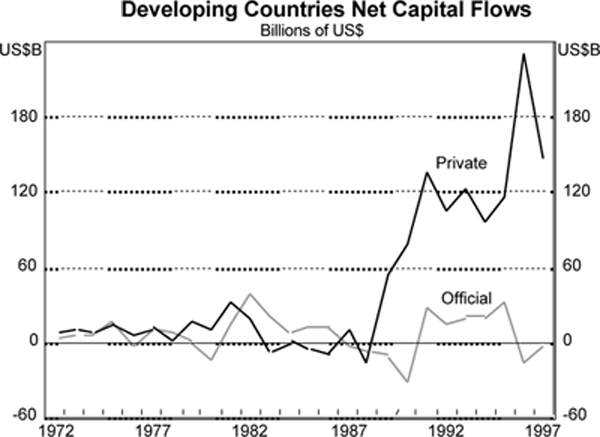
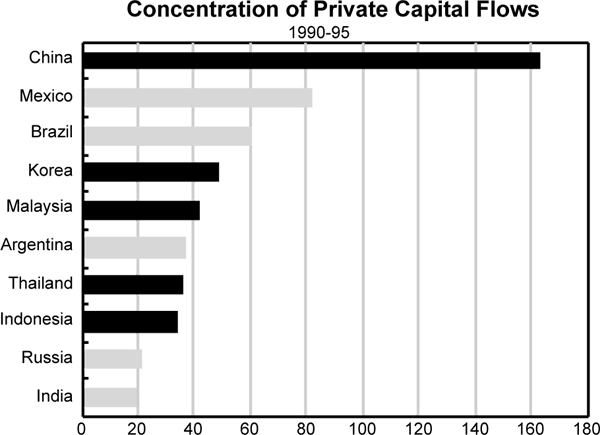
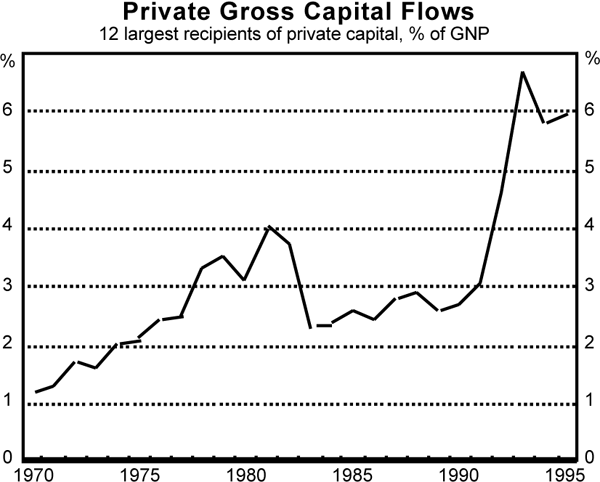
Developing Countries Net Private Capital Flows
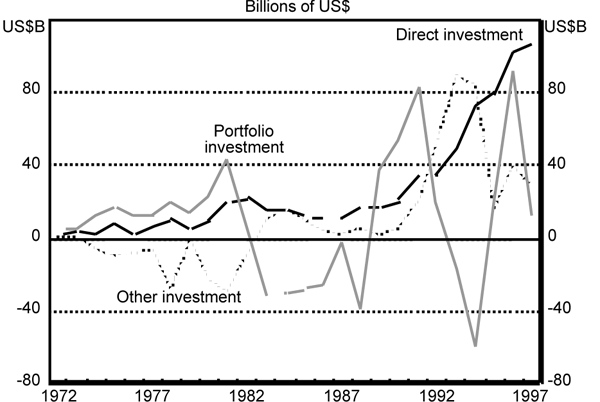
At the same time as these large mutual funds were discovering the attractions of diversification, the financial infrastructure to implement this was also being put in place, mainly driven by international financial institutions searching out expansion opportunities. They were encouraged in this by the general intellectual climate which promoted globalisation, and by the official international financial institutions (IMF, World Bank, and so on) who saw freeing up of financial capital as an important part of the development process.[3],[4] The recipient countries were happy enough to see these flows, as they themselves embraced the increasing sophistication of their financial infrastructure as a symbol of modernity and as a driving force for the growth. Progressive dismantling of capital controls in the recipient countries was a factor, but in a number of cases the capital accounts had already been substantially opened (in Indonesia, for instance, capital flows were, to all intents and purposes, free from 1970 onwards).
It was not so much change of regulation but change of attitude and perceptions that was the driving force of the enormous increases in capital flows. By 1990, a number of these countries had recorded two decades of high growth and had established an enviable track record of political stability, balanced budgets and lowish inflation. If there was an ‘economic miracle’ occurring (c.f. World Bank, 1993), it is not surprising that foreign investors wanted a slice of the action.
Not least, domestic investors in these countries took the opportunity of what looked like extremely low borrowing rates on these overseas funds to finance an investment boom, including, inevitably, a good share of over-investment and misplaced investment.
These big flows (and the big current account deficits that went with them) were not some kind of aberration, but reflected the normal working of market forces. For those who find these deficits to be aberrant behaviour, could I remind you of the Feldstein and Horioka (1980) analysis, which suggested that the true aberrant behaviour was the close correspondence between saving and investment within most countries in the world. In other words, the amount of capital flow between countries has been smaller than optimal behaviour would seem to suggest. While a number of poor investment opportunities were certainly undertaken (most notably, excessive real estate investment), at an aggregate level it is still correct to say that there were many high profit opportunities available in these countries, as they moved from well inside the technological frontier towards the frontier itself, driven by an eagerness to adopt all sorts of productivity-enhancing techniques.
If all this sounds a bit textbook-ish, consider the experience of Singapore. As shown in Graph 5, they ran a current account deficit averaging more than 10 per cent of GDP for two decades, in a period of policy-making which would universally be regarded, with hindsight, as extremely successful. I should remind you also that all these countries ran, in the textbook sense, ‘good’ deficits – i.e. they were used to fund investment and not consumption, and were certainly not funding budget deficits.
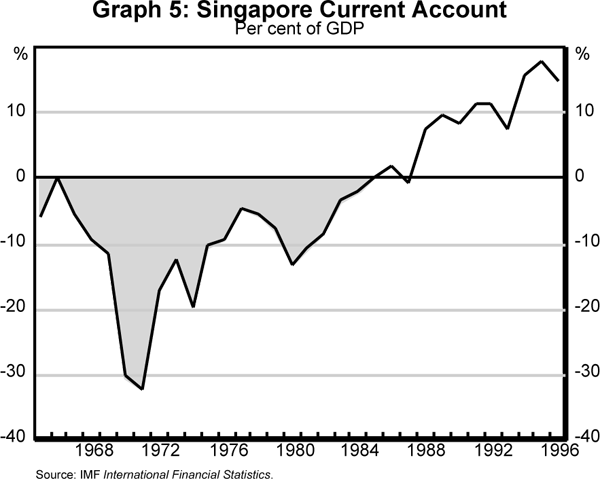
| Saving (% of GNP) |
Investment (% of GNP) |
CAB (% of GDP) |
Budget Balance (% of GDP) |
||
|---|---|---|---|---|---|
| Indonesia | 31.8 | 34.1 | −2.5 | 0.8 | |
| Malaysia | 34.2 | 40.5 | −6.3 | 0.1 | |
| Philippines | 18.7 | 21.7 | −3.4 | −0.6 | |
| South Korea | 35.4 | 36.9 | −1.3 | −0.2 | |
| Thailand | 34.9 | 41.8 | −6.4 | 2.9 | |
| Memo: | Mexico | 17.6 | 19.4 | −5.2 | 0.1 |
| United States | 15.5 | 16.0 | −1.2 | −3.6 | |
| Germany | 21.8 | 22.2 | −0.9 | −2.0 | |
| Japan | 34.8 | 30.4 | 2.6 | −0.6 | |
Some of these countries understood, perhaps intuitively more than by rigorous logic, that big current account deficits made them vulnerable: Indonesia, for instance, was uncomfortable if its current account deficit was above 3 per cent of GDP. Korea, too (in recent years at least), ran quite modest current account deficits. But by and large, once these countries accepted the idea of financial deregulation and open markets, they were going to be on the receiving end of very substantial capital inflows.[5]
There is not a lot of point in trying to identify precisely whether the capital flows were more supply-driven than demand-driven, because we have known since Marshall that the outcome depends on the two blades of the demand and supply scissors. Nevertheless, it might be worth noting that the financial flows were often significantly larger than the amount that could be absorbed in terms of real flows of goods and services – i.e. the capital inflow was larger than the current account deficit: Graph 6 illustrates this.
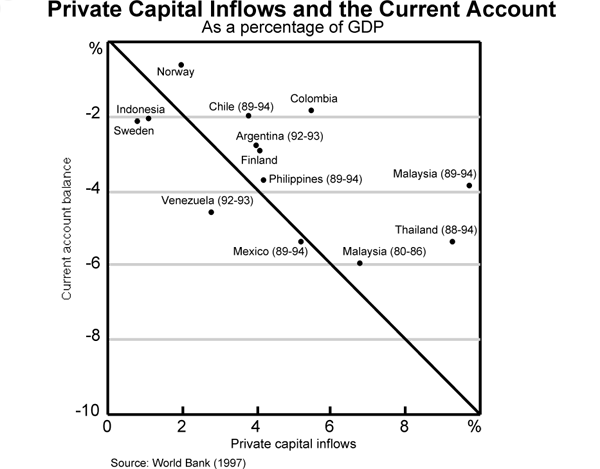
We will return, later, to the issue of whether the policy problems created by these huge capital flows (and the resultant rapid growth of domestic credit) could have been avoided by a different exchange rate regime. The basic point made here is that these countries embodied significant profit opportunities (albeit with lots of opportunities to over-invest and invest in the wrong industries), and that it was normal for large amounts of capital to flow from the ‘old world’ of savers towards the new opportunities available in these countries.
The second major issue behind exchange rate fluctuations revolves around perceptions of how the economy works – ‘the model’. What is the ‘mind-set’ of participants in the market – what do they think is the ‘proper’ exchange rate? This is based not just on their views about some ‘fundamentals’, but also their guesses about other market participants' views, so there is certainly plenty of opportunity for exchange rates to move very significantly, and stay away from the underlying fundamentals for significant periods of time. We noted, earlier, that this has happened in the case of countries such as the United States, Japan and Australia, where there are well-developed views about how the economy works and detailed analytical and econometric studies of what proper pricing relativities should be.
The ‘models’ or ‘mind-sets’ for the countries in question are much less fully developed and universally held, so there is far more opportunity for prices to shift sharply, and stay at rates which, earlier, would have seemed abnormal. On top of this, there are substantial information asymmetries, asymmetries which made market participants very nervous about going against the run of the market or taking significant contrarian positions.
This combination – very large, footloose capital flows and an exchange rate not firmly anchored by ‘fundamentals’ – goes a long way to explain the big exchange rate moves. When sentiment and confidence changed and the original investors began to pull out their capital, the exchange rate fall did nothing to induce new inflows. Where were the stabilising speculators of textbook theory, who were supposed (in the textbook view) to respond to the fall in the exchange rate by recognising that, once the exchange rate was below its fundamental level, there was a profit opportunity for those who bought the currency? In the absence of a firmly-defined ‘fundamental’ equilibrium exchange rate, as the exchange rate fell, the market changed its view on what was the ‘correct’ equilibrium rate. Even when most market participants agreed that exchange rates had gone too far, they recognised the possibility that they could go further still. To stand against the run of the market in a contrarian position might be ultimately vindicated, but in the short run required a degree of courage and confidence that no fund manager (whose performance is evaluated more-or-less constantly) could afford to take. In short, there were no equilibrating flows to anchor the exchange rates.
How should exchange rates behave?
Let's try to develop this a bit further to see whether there is any clear, fairly universally-accepted idea of how exchange rates should move in the circumstances in which these countries found themselves.
Perhaps the nearest guidance we can get from formal academic ideas is the old discussion about the ‘transfer problem’. The key point is that as financial flows shift from one country to another, it is necessary to induce equivalent real flows of goods and services (which would take the form of a current account deficit, corresponding to the financial flows in the capital account). The old literature observed that there could be a wide range of outcomes for the ‘transfer problem’: where the financial flow took the form of direct foreign investment, the same decision about the financial flow generally induced the real flow – as a company decided to invest overseas, it shipped plant and machinery in roughly corresponding amount. But if the flows took the form of portfolio investment, then the exchange rate had to appreciate to encourage the real resource transfer.
The other longer-term structural influence on the exchange rate was the rapid productivity increases in the tradeables sectors: in theory, these countries might have expected to find, over time, their real exchange rates appreciating. In the Balassa/Samuelson (1964) model, productivity rises fastest in the tradeables sector, and equilibrium requires a higher real exchange rate.
Of course, there were other forces at work. In 1996, there was a very significant fall in the terms of trade of these countries.[6] And the story is further complicated by the specific nature of the exchange rate regime – fixed more-or-less to the US dollar – so the effective exchange rate swung with the US dollar. To further complicate the picture, capital flows responded to the changing monetary stance in the big capital-exporting countries – low interest rates in Japan in recent years encouraged the so-called ‘carry trade’ – borrowing at low interest rates in Japan and lending at high rates elsewhere in Asia.[7]
These factors were transient, and taking the dominant structural elements as being the capital transfer issue and Balassa/Samuelson, it was not surprising to find upward pressure on exchange rates during the 1990s and some modest appreciation of real exchange rates. The exchange rate strength might have been expected to last for a considerable length of time, and perhaps become permanent because of the structural improvement in productivity. The relatively modest increases in the real exchange rate seen in countries like Thailand were thus not, in themselves, a clear indicator of an over-valued exchange rate or impending depreciation.
In the face of this upward pressure on the exchange rate, the policy approach of these countries over the decade (until 1997) had been to resist significant appreciation. This is reflected in the increase in their foreign exchange reserves (Table 3). Why did they resist the upward pressure? This was, in part, because the lower exchange rate was seen as offering a beneficial general incentive for the most dynamic parts of the economy – the tradeables sector and, in particular, the export sector. Partly, too, it reflected a perception that high exchange rates left countries vulnerable to sudden changes in sentiment. Looking at the experience of these countries, it is hard to disagree strongly with these sentiments. Dornbusch (1994, p. 280), writing about Mexico, notes “… over-valuation is one of the gravest policy errors along the way. Over-valuation stops growth and, more often than not, ends in a speculative siege on the exchange rate and ultimately currency realignment”.[8]
| Indonesia | 9 |
|---|---|
| Malaysia | 16 |
| Philippines | 7 |
| South Korea | 20 |
| Thailand | 20 |
|
Source: IMF, International Financial Statistics |
|
Lessons
I have tried to put the case that the capital inflows that occurred into these countries in the first half of the 1990s were not some aberration of policy-making, but were more-or-less to be expected. But we now know, with hindsight, that they were unsustainable. Where did it go wrong? What should be done?
The first lesson is that whatever the ‘model’ suggests is the norm for capital flows, when these flows get large, economies are vulnerable to changes in sentiment. The model does not say much about how policies should handle changes of sentiment which bring very large variance to capital flows and GDP. Wherever there are large foreign capital flows, there is a high probability of rapid changes of mood, because – whoever bears the exchange rate risk (whether borrower or lender) – one of the parties to the transaction is holding an exchange rate position which is not ‘natural’. This makes that party flighty and quick to re-assess their position. In many cases, the response was that the party with the most information bore the exchange rate risk – i.e. the domestic borrower borrowed in foreign currency. It was not irrational to expect exchange rates to remain reasonably stable, not only because policy in these countries had succeeded in keeping a high degree of stability over a reasonably long period of time, but also because (based on our earlier argument) they might have expected, if anything, the exchange rate to appreciate over time, which would have reduced the cost of their overseas borrowing.[9] But in the end it was the old issue of variance or the variability over time that brought the best-laid plans of borrowers to such an unhappy end. We noted earlier that the textbook equilibrating forces were largely absent – as foreign exchange became dearer, people wanted to buy more, not less. This was reinforced by lenders' behaviour. As the exchange rates fell, foreign lenders, although protected from exchange rate risk, began to realise that they were exposed to increasing credit risk, and became extremely reluctant to roll over their lending. The credit-rating agencies added their own special twist-of-the-knife, down-grading these countries six months after the problems began, so that portfolio managers were forced to sell into the collapsed markets.
Now we have looked at some of the forces operating on the exchange rate, we can ask: ‘would an earlier float of the exchange rate have avoided these problems?’. With hindsight, it is hard to argue against this view – the actual path proved unsustainable, so any alternative looks attractive. But this does not tell us whether the alternative would, in fact, have handled the situation more satisfactorily: for this, we would need to sketch out what the exchange rate path over time would have been under this alternative scenario. Given the capital-transfer process underway, how much would the exchange rate be expected to appreciate? This is hard to think through, but the key idea here is that an interest rate differential should be balanced by an expectation of exchange rate depreciation if portfolios are to be held in balance. Portfolio equilibrium could not be achieved by lowering domestic (local currency) interest rates, because these were set – in effect – by the high domestic marginal efficiency of capital: high interest rates were needed to rein in the intrinsic dynamism of the domestic economy. If the interest differential was expected to be maintained for a significant period of time (say, a decade or more), then there would need to be a very large appreciation of the exchange rate to balance the likelihood that interest differentials would be maintained over this period of time. How far would it have had to appreciate before foreign investors would have stopped extrapolating the appreciation and begun to expect depreciation? Would this process have been smooth, without the over-shooting we have seen? What sort of knife-edge equilibrium would this have been, in which portfolio managers' calculations teeter between the recent history of appreciation, but incorporate a steady, gentle, expected depreciation from here on? Would the even-higher current account deficits that would have occurred during the appreciation phase have spooked the market? There are no answers to these ‘what if’ questions, but it seems naive to argue that markets would have maintained a smoothly-evolving equilibrium exchange rate through the extraordinary changes of the 1990s. Greater exchange rate flexibility may well have provided a better outcome (or, more likely, brought on the crisis earlier), but it needed to occur within a financial infrastructure which had the capacity to withstand the exigencies of real-world flexible markets.
I now turn to more immediate issues, particularly the events of 1997. Once exchange rates were floated, why didn't higher interest rates work more effectively to stabilise the exchange rates of these countries? There are new lessons and old lessons to be re-learned:
- if the market does not believe that high interest rates will be sustained, then there is no encouragement to capital inflows (and, in fact, the market may think that the exchange rate will fall further when the unsustainable interest rates are lowered);
- high interest rates are supposed to work by encouraging domestic borrowers to roll over their foreign exchange debt and borrow more overseas, and by encouraging foreigners to lend more, denominated in domestic currency. But foreigners are now worried about credit risk: higher local-currency interest rates do not encourage them to roll over their foreign exchange loans (in fact, will cause them to worry more about the financial health of their debtors), and it seems unlikely that many foreigners will be tempted to lend in local currency (the Stiglitz and Weiss (1981) ‘adverse selection’ argument is relevant here: only the most daring (and therefore risky) borrowers will be willing to pay higher interest rates).
None of this, of course, argues for low interest rates – but it is a reminder that simple manipulation of interest rates will not always protect an exchange rate.
What other lessons should be drawn, specifically on the appropriate exchange rate regime for the future? Policy-makers of these countries always accepted, in principle, that as their countries became more integrated with the outside world, they would not be able to control both interest rates and the exchange rate. They understood this, but were perhaps hoping to put off the day for somewhat longer. It seems unlikely, now, that these countries can go back to anything like the fixed exchange rates that they had before: nor would this be desirable. But we could also understand if the policy-makers of the region find both the extent of the movement and the actual levels which the market has now produced to be aberrant, and hardly a recommendation for ‘leaving it up to the market’. Those of us who have experienced floating exchange rates for some time now might offer a couple of points:
- like them, Australia did not float because we had decided that it was a good idea, but because we were forced by circumstances to do so;
- like them, Australia found the initial stages of the float to be extremely uncomfortable, and even over the longer term, there seem to have been moments when the exchange rate was not closely anchored by the fundamentals;
- nevertheless, most of us have come to the view that floating exchange rates work well for us (although there will be times when we believe we can do beneficial intervention in the market). Our systems have built up some resilience as people become more accustomed to exchange rate swings, and build these variations into their decisions.[10]
It is also clear that the proper answer is not to restrict capital flows, although these countries may be, in future, less enthusiastic about encouraging some of the more footloose and volatile forms of capital inflow. These countries should move forward with financial deregulation, although the central lesson from this experience is that the prudential framework should advance in step with the opening up of the financial sector.[11] The sine qua non of smooth adaptation to large capital flows must be a resilient and robust formal financial sector, with risk-averse conservative banks forming a large stable core. Such risk-averse institutions would have been reluctant to expose themselves to the sort of exchange rate shocks that have occurred, and so a well-functioning formal financial sector would have borrowed less in foreign currency and would have been more conscious of the credit risk of lending to those who had borrowed extensively overseas. To the extent that this left private non-bank borrowers still borrowing excessively in foreign currency, then we might hope that the ‘consenting adults’ view would prevail, leaving the borrower and lender to sort out repayments on a one-on-one basis without putting the entire economy at risk. But those who are confident that this private non-bank borrowing will be a smooth, well-informed process might contemplate just how quickly private investors changed from wide-eyed enthusiasm to gloomy disillusionment, and how slow the international credit agencies were to see the impending problems. The alarm-bells went off when the building was well-and-truly ablaze. The problems of lack of a clearly-understood model and asymmetrical information may be addressed by greater transparency and provision of data, but it hardly seems likely that they can be overcome. The lesson we should draw from all this is that inconvenient fluctuations in exchange rates are inevitable, and we have to design systems which can cope with them.
To put this point in different words, we need to enlarge our view of ‘the fundamentals’. To the conventional list of ‘fundamentals’, we need to add another vital one – some assessment of the health and resilience of the financial system. Whether these countries can afford to return to their old pace of growth depends very largely on their ability to cope with variance – particularly variance of capital flows and exchange rates. So the constraint on growth will not be the conventional one of available resources, but whether the financial sector has proven itself to be able to withstand vigorous ‘stress-testing’ – can it withstand big exchange rate changes? Can it cope with asset booms and busts? It also needs to be able to handle big swings in perceived company profitability, because we know that a project which is performing well in an environment of 8 per cent growth can turn into a loser when growth slows.
I have already noted how important it is to improve prudential supervision in these countries. This is not controversial, although putting it into practice will be difficult and time consuming. One more-controversial element would be an effort on the part of the prudential authorities in the capital supplying countries to go beyond assuring themselves that their own banks are acting prudently and – in addition – asking whether their actions may be putting the recipient country's financial institutions at risk. This would seem to require a greater degree of co-operation than exists (or is envisaged) at the moment.
In short
Large and volatile capital inflows are an inevitable part of the international context in which these countries operate. Even with a floating exchange rate, very large medium-term exchange rate changes can be expected. This will put a lot of pressure on the solvency of firms and, more particularly, banks. You therefore need a sound, well-supervised and risk-averse banking system. This is an essential part of a deregulated financial market, but one that many Asian countries lack.
It may not be possible to return to the highest of the growth rates seen in the previous three decades, but fast rates of growth are still possible, and eminently desirable. The countries which get back there quickest will be those which are able to put in place institutions which can withstand the changes of sentiment which are part-and-parcel of a globalised economy.
Endnotes
I am grateful for the help of John Hawkins and Amanda Thornton in preparing this paper. [*]
Among the Asian countries themselves, it is worth recalling that Indonesia, as a conscious and deliberate element of macro policy, changed its exchange rate by large amounts three times in the late 1970s and 1980s, at a time when it had a fixed exchange rate and there was no pressing need for exchange rate changes – they were well-conceived macro policy responses to emerging policy problems, and were taken on in the well-founded belief that exchange rate changes of this size could be absorbed by the economy. [1]
One other point worth noting is the disparity between the size of these funds and the size of the recipient countries. Even though these funds have not diversified all that much, their size is enormous. Even if the US mutual funds bought every share listed on the ASEAN stock markets, this would still represent less than a tenth of their assets. [2]
Korea, for example, as a pre-condition for entry into the OECD ‘rich countries'’ club, had further to deregulate capital flows. [3]
Coming out of this, we saw such developments as the Bangkok International Banking Facility, which began as an offshore banking centre, but very quickly developed into the smooth facilitator of massive flows of capital into Thailand (over $10 billion per year – more than 10 per cent of GDP – since 1993) At the same time, Thai finance companies hoped to improve their claims for banking licences by facilitating inflows. [4]
Indonesia also understood that it was difficult to put in place the necessary prudential structure in time to keep pace with the burgeoning capital inflows. The central bank Governor has noted: ‘we started building the foundations of a house but suddenly we had to host a party’. [5]
For example, the price of a standard computer chip fell from $50 in late 1995 to under $10 in 1996. [6]
Some argue that the reversal of capital flows to East Asia was triggered by market fears that Japanese interest rates were about to rise, putting an end to the ‘carry trade’. [7]
It is worth noting that Mexico's exchange rate over-valuation problem in 1994 was quite different from any Asian experience – a fixed rate regime had been used by Mexico as an anchor while inflation was reduced, with the inevitable consequence of over-valuation. [8]
Were they foolish not to hedge their borrowing? This is a common ex post criticism, but it seems to ignore the obvious financial-market identity that if they had hedged their borrowing, then they would have eliminated the interest rate advantage of borrowing in foreign currency. This does not say that it would have been unwise to hedge – merely that it is understandable that they did not. [9]
This is not to argue that the sort of exchange rate changes which have occurred in Asia are helping to bring about a new and beneficial equilibrium. They are, in fact, very damaging, not just because of the inappropriate price signals they embody, but because of the high interest rates used to contain the exchange rate movements, and the damage to firms which have borrowed in dollars. Much more modest changes would have achieved an improved competitiveness, and as far as capital flows are concerned, big movements in exchange rates seem to be inhibiting rather than encouraging capital flows, by worsening the basic situation in these countries, reducing profitability, limiting GDP growth and creating substantial policy-making uncertainty. It might be worth noting, too, that in the Mexican case, the large nominal exchange rate fall which was initially seen (in 1994/95) as being an important part of the corrective process has been more-or-less offset by subsequent inflation, so that the improvement in the real exchange rate and competitiveness has been largely lost. [10]
When people used to argue about the correct sequencing for the deregulatory process, they recognised that financial deregulation should come last, because if there remained any opportunities for disequilibrium profits in the meantime, a very open financial sector would allow these to be exploited. [11]
References
Balassa, B. (1964), ‘The Purchasing Power Parity Doctrine: A Reappraisal’, Journal of Political Economy, Vol. 72, No. 6, pp. 584–596.
Dornbusch, R. (1994), ‘Mexico: Stabilization, Reform and No Growth’, Brookings Paper on Economic Activity, pp. 253–315.
Feldstein, M.S. and C.Y. Horioka (1980), ‘Domestic Saving and International Capital Flows’, Economic Journal, June, Vol. 90, pp. 314–329.
Grenville, S.A. (1997), ‘Asia and the Financial Sector’, Reserve Bank of Australia Bulletin, December.
Samuelson, P.A. (1964), ‘Theoretical Notes on Trade Problems’, Review of Economics and Statistics, Vol. 23, pp. 1–60.
Stiglitz, J.E. and A. Weiss (1981), ‘Credit Rationing in Markets with Imperfect Information’, American Economic Review, Vol. 71, pp. 393–410.
World Bank (1993), East Asian Miracle: Economic Growth and Public Policy, World Bank Policy Research Report.
World Bank (1997), Private Capital Flows to Developing Countries: The Road to Financial Integration, World Bank Policy Research Report.